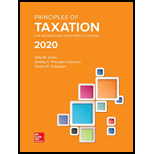
Principles of Taxation for Business and Investment Planning 2020 Edition
23rd Edition
ISBN: 9781260433210
Author: Jones, Sally
Publisher: MCGRAW-HILL HIGHER EDUCATION
expand_more
expand_more
format_list_bulleted
Concept explainers
Question
Chapter 7, Problem 1AP
a.
To determine
Calculate the after-tax cost of the given business expenditure.
b.
To determine
Calculate the after-tax cost of the given business expenditure.
c.
To determine
Calculate the after-tax cost of the given business expenditure.
d.
To determine
Calculate the after-tax cost of the given business expenditure.
e.
To determine
Calculate the after-tax cost of the given business expenditure.
Expert Solution & Answer
Want to see the full answer?
Check out a sample textbook solution
Students have asked these similar questions
Account
Not use ai solution please and accounting question
Accounting question correct option
Chapter 7 Solutions
Principles of Taxation for Business and Investment Planning 2020 Edition
Ch. 7 - Prob. 1QPDCh. 7 - Assume that Congress enacted legislation requiring...Ch. 7 - Prob. 3QPDCh. 7 - To what extent do cost recovery deductions based...Ch. 7 - Can a firm have a negative tax basis in an asset?Ch. 7 - Prob. 6QPDCh. 7 - Corporation J manufactures electrical appliances....Ch. 7 - Identify the tax and nontax issues that firms must...Ch. 7 - Identify four possible differences in the...Ch. 7 - Prob. 10QPD
Ch. 7 - Prob. 11QPDCh. 7 - Prob. 12QPDCh. 7 - Prob. 13QPDCh. 7 - Prob. 14QPDCh. 7 - Prob. 15QPDCh. 7 - Prob. 16QPDCh. 7 - Prob. 17QPDCh. 7 - Prob. 18QPDCh. 7 - Prob. 1APCh. 7 - Assuming a 21 percent tax rate, compute the...Ch. 7 - Determine the tax basis of the business asset...Ch. 7 - ABC Company purchased business property several...Ch. 7 - Early this year, ZeZe Inc. paid a 52,000 legal fee...Ch. 7 - In year 1, Firm A paid 50,000 cash to purchase a...Ch. 7 - Prob. 7APCh. 7 - Hansen Company, a cash basis taxpayer, paid 50,000...Ch. 7 - In year 0, Jarmex paid 55,000 for an overhaul of a...Ch. 7 - Prob. 10APCh. 7 - Refer to the facts in problem 10. In its second...Ch. 7 - In its first year of operations, Lima Company...Ch. 7 - Prob. 13APCh. 7 - Herelt Inc., a calendar year taxpayer, purchased...Ch. 7 - Knute Company purchased only one asset during its...Ch. 7 - Prob. 16APCh. 7 - Suber Inc., a calendar year taxpayer, purchased...Ch. 7 - Prob. 18APCh. 7 - Prob. 19APCh. 7 - On May 12, 2018, Nelson Inc. purchased eight...Ch. 7 - In March 2018, Jones Company purchased a Mercedes...Ch. 7 - Margo, a calendar year taxpayer, paid 580,000 for...Ch. 7 - In 2019, Firm L purchased machinery costing 21,300...Ch. 7 - In 2018, Company W elected under Section 179 to...Ch. 7 - Prob. 25APCh. 7 - At the beginning of its 2019 tax year, Hiram owned...Ch. 7 - In April 2019, Lenape Corporation completed...Ch. 7 - Ajax Inc. was formed on April 25 and elected a...Ch. 7 - Prob. 29APCh. 7 - Mr. Z, a calendar year taxpayer, opened a new car...Ch. 7 - Prob. 31APCh. 7 - Prob. 32APCh. 7 - Prob. 33APCh. 7 - Prob. 34APCh. 7 - Prob. 35APCh. 7 - Prob. 36APCh. 7 - Prob. 37APCh. 7 - Prob. 1IRPCh. 7 - Prob. 2IRPCh. 7 - Prob. 3IRPCh. 7 - Prob. 4IRPCh. 7 - Prob. 5IRPCh. 7 - Prob. 6IRPCh. 7 - Prob. 7IRPCh. 7 - Prob. 8IRPCh. 7 - Prob. 9IRPCh. 7 - Prob. 10IRPCh. 7 - Prob. 1RPCh. 7 - Prob. 2RPCh. 7 - Prob. 3RPCh. 7 - Prob. 4RPCh. 7 - Prob. 1TPCCh. 7 - Prob. 2TPCCh. 7 - Prob. 3TPCCh. 7 - Prob. 4TPC
Knowledge Booster
Learn more about
Need a deep-dive on the concept behind this application? Look no further. Learn more about this topic, accounting and related others by exploring similar questions and additional content below.Similar questions
arrow_back_ios
SEE MORE QUESTIONS
arrow_forward_ios
Recommended textbooks for you
 Intermediate Accounting: Reporting And AnalysisAccountingISBN:9781337788281Author:James M. Wahlen, Jefferson P. Jones, Donald PagachPublisher:Cengage LearningPrinciples of Accounting Volume 1AccountingISBN:9781947172685Author:OpenStaxPublisher:OpenStax College
Intermediate Accounting: Reporting And AnalysisAccountingISBN:9781337788281Author:James M. Wahlen, Jefferson P. Jones, Donald PagachPublisher:Cengage LearningPrinciples of Accounting Volume 1AccountingISBN:9781947172685Author:OpenStaxPublisher:OpenStax College


Intermediate Accounting: Reporting And Analysis
Accounting
ISBN:9781337788281
Author:James M. Wahlen, Jefferson P. Jones, Donald Pagach
Publisher:Cengage Learning

Principles of Accounting Volume 1
Accounting
ISBN:9781947172685
Author:OpenStax
Publisher:OpenStax College